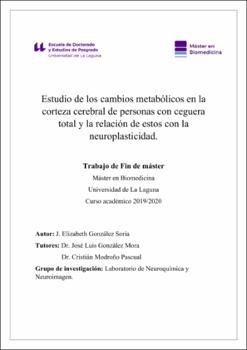Estudio de los cambios metabólicos en la corteza cerebral de personas con ceguera total y la relación de estos con la neuroplasticidad.
Fecha
2021Resumen
En este trabajo se ha estudiado las diferencias de concentración de metabolitos presentes en la corteza primaria del cerebro en 7 pacientes que presentan ceguera total respecto a 8 controles sanos. Se realizó a través del uso de resonancia magnética (MR) usando tanto imagen por resonancia magnética (MRI) para observar si existían anomalías en las regiones a estudiar, así como espectroscopia de resonancia magnética (MRS), especialmente la de protón, (1H-MRS), para registrar las concentraciones moleculares presentes en el tejido biológico usando las propiedades magnéticas de los átomos de hidrogeno localizados en dichas zonas cuando se ven expuestos a un campo magnético. Se ha tenido en cuenta trabajos anteriores en la preparación de esta investigación, ya que en estos se muestran los cambios neuroquímicos en la corteza visual mostrando diferencias en los metabolitos estudiados, aunque no hay respuestas claras sobre cómo se producen estos cambios ni como los procesos de neuroplasticidad pueden intervenir. Este trabajo pretende estudiar y aclarar los cambios producidos en un mayor número de metabolitos que los que presentan bibliografías anteriores, en ambos hemisferios cerebrales. Realizando distintos de análisis estadístico se obtuvo que los cambios metabolitos se producían en Glc, GPC, NAA, GPC+PCh, NAA+NAAG y Cr+PCr. No obteniendo diferencias significativas en los estudios de variables como el sexo, la edad y tiempo de aparición. Por último, se realizó un estudio para comprobar que los hemisferios derecho e izquierdo forman parte de un área homogénea del cerebro. En conclusión, con las variaciones obtenidas logró dar respuestas a los cambios metabólicos y la relación que guarda con la neuroplasticidad. In this work, the differences in metabolite concentration present in the primary cortex of the brain in 7 patients with total blindness compared to 8 healthy controls have been studied. It was performed through the use of magnetic resonance (MR) using both magnetic resonance imaging (MRI) to observe if there were abnormalities in the regions to be studied, as well as magnetic resonance spectroscopy (MRS), especially that of proton, (1HMRS), to record the molecular concentrations present in biological tissue using the magnetic properties of the hydrogen atoms located in these areas when exposed to a magnetic field. Previous work has been taken into account in the preparation of this research, since these show the neurochemical changes in the visual cortex showing differences in the metabolites studied, although there are no clear answers on how these changes occur or how the processes of neuroplasticity can intervene. This work tries to study and clarify the changes produced in a greater number of metabolites than those presented in previous bibliographies, in both cerebral hemispheres. Carrying out different statistical analyzes, it was obtained that the metabolite changes occurred in Glc, GPC, NAA, GPC + PCh, NAA + NAAG and Cr + PCr. Not obtaining significant differences in the studies of variables such as sex, age and time of onset. Finally, a study was carried out to verify that the right and left hemispheres are part of a homogeneous area of the brain. In conclusion, with the variations obtained, it was able to provide responses to metabolic changes and the relationship it has with neuroplasticity.





